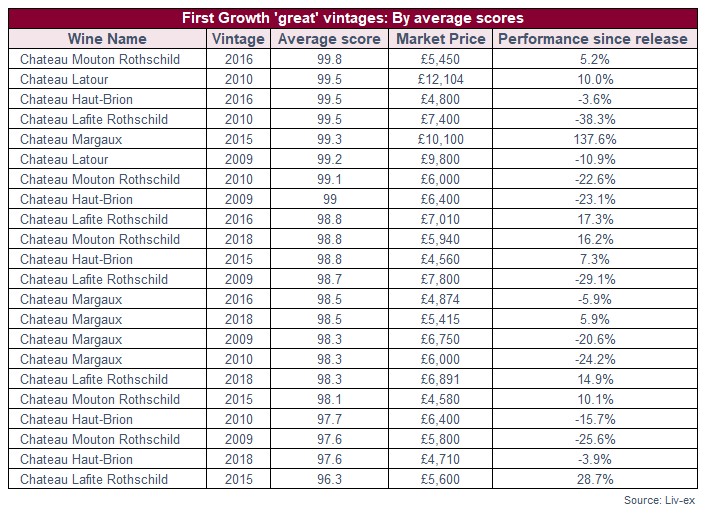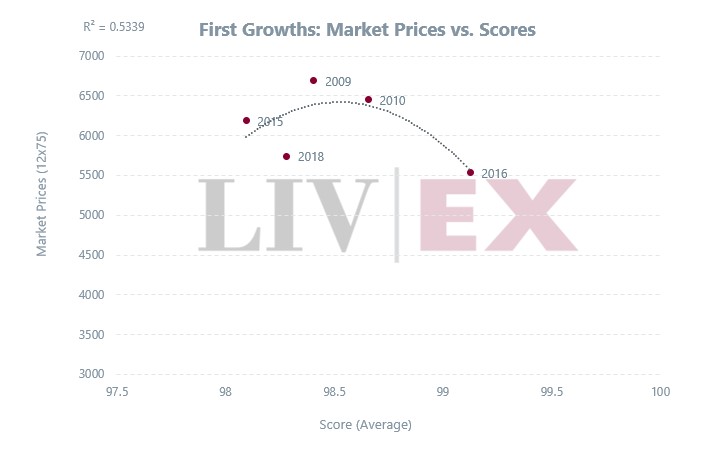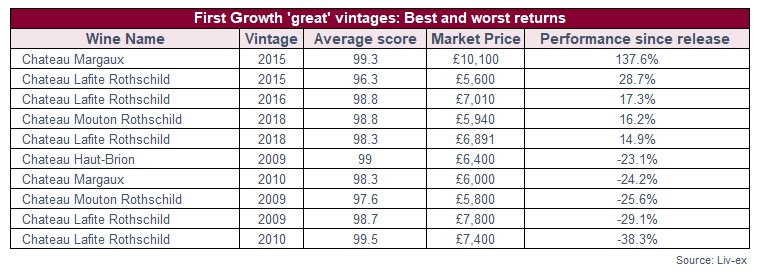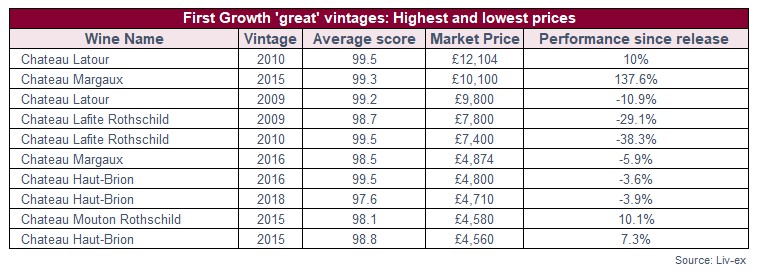Following on from a recent Market Update on finding value among the First Growths in ‘great’ vintages, what else can be learned when comparing Bordeaux’s big five at their best?
Looking at each estate individually, we can see that from the 2009, 2010, 2015, 2016 and 2018 vintages:
- Lafite’s record is one of extremes. It has the weakest rated vintage on average among the First Growths (the 2015), while its best-rated vintage (the 2010) has also been the worst overall performer post primeurs.
- Mouton has the best-rated wine overall (the 2016), which is also the second-cheapest Mouton from this selection of five vintages.
- Haut-Brion has some of the least expensive prices for these vintages, with its 2015 being the cheapest case overall and 2016 the third best rated.
- Margaux has a very solid average set of scores while its 2015 vintage is its best-rated and the second most expensive wine overall, but which has also seen the greatest returns since release.
- Latour has one of the highest set of average points, with nearly all five vintages rated 99. Its 2010 is the most expensive but is the only 2010 First Growth to have appreciated since release.

*This list exlcudes Latour 2015, 2016 and 2018 because the wines have not been released. The average score for each vintage is; 97.6, 99.4 and 98.5 respectively.
As the Market Update pointed out, taking the vintages 2009, 2010, 2015, 2016 and 2018 into account, and using an average score drawn from a pool of critics that comprises Neal Martin and Antonio Galloni at Vinous, Lisa Perrotti-Brown MW and James Suckling, Mouton Rothschild’s 2016 is the top-rated wine.
With an average score of 99.8, that’s almost as close to a clean sweep of ‘perfect’ scores as one is likely to see, and at £5,450 per 12×75, the 2016 is one of the lower priced Mouton wines from this selection of vintages.
As can be seen in the chart below, the 2016s as a group look to offer significant value versus the other four vintages, with the highest average score and lowest average prices. The highest-priced 2016 First Growth is the Lafite at £7,010 per dozen, while Haut-Brion and Margaux’s 2016s are both sub-£5,000.

Opportunities among 2018s
Interestingly, the 2018s are the next cheapest group and while many other Bordeaux 2018 wines have struggled to hold their value since they were offered En Primeur, this is not true of the First Growths.
Although Haut-Brion’s price has dipped slightly (3.9%) and Latour has not yet released its 2018, the other three have enjoyed gains, with those of Lafite and Mouton, 16.2% and 14.9%, counting for some of the strongest price rises among this particular set of vintages.
It should be remembered though that both vintages (and the 2015) are missing the price of Latour which would undoubtedly raise their average prices considerably as it has done to the 2009 and 2010 vintages.
Best performer
 The 2015s, by contrast, lag behind the other vintages, with the lowest set of average scores and yet they are simultaneously more expensive than the ‘fair value’ line would suggest they should be.
The 2015s, by contrast, lag behind the other vintages, with the lowest set of average scores and yet they are simultaneously more expensive than the ‘fair value’ line would suggest they should be.
This is and is not true. The 2015 First Growths certainly have some of the lowest average scores – the 2015 Lafite has the lowest cumulative score of all (96.3) – but the prices are actually some of the lowest. Haut-Brion’s 2015 is the cheapest 12-pack in this vintage selection, while Lafite and Mouton’s 2015s are also the cheapest option at those properties. All three have gained in value since their release as well.
What really throws 2015s price average off is the £10,100 Market Price for the Margaux. The 2015 was both an anniversary vintage for the estate but also the final vintage of technical director Paul Pontallier who died the following year. Taking these factors into account and as the best-rated First Growth in 2015, this is the best-performing First Growth from among these top vintages overall; up 137% since release.
‘Greatest’ of all?
 Finally there are the 2009 and 2010 vintages. At both a group and individual level, the wines from these vintages have some of the strongest average scores. Half of the First Growths’ wines from these vintages carry an average score of 99.
Finally there are the 2009 and 2010 vintages. At both a group and individual level, the wines from these vintages have some of the strongest average scores. Half of the First Growths’ wines from these vintages carry an average score of 99.
On the other hand they also the most expensive. Four of the top five highest prices one can pay for a case of a First Growth are from the 2009 or 2010 vintages. Latour’s 2010 at £12,104 is the most expensive wine overall.
On the other hand, they have also experienced the worst returns among all these ‘great’ vintages. Across all five First Growths, there is only one wine that has not drifted in price since release; the Latour 2010, which is up 10%. And Lafite’s 2010, which has declined 38% in price since release, is the worst-performing First Growth from this group.
The Liv-ex 2020 En Primeur Report is now available to read and download exclusively to members here.
Liv-ex will be analysing and publishing Bordeaux analyses in the run up to and throughout the upcoming 2020 En Primeur campaign. For instant email alerts, subscribe below.






